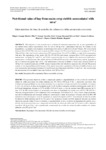Por favor, use este identificador para citar o enlazar este ítem:
http://www.alice.cnptia.embrapa.br/alice/handle/doc/982895Registro completo de metadatos
| Campo DC | Valor | Lengua/Idioma |
|---|---|---|
| dc.contributor.author | MOREIRA FILHO, M. A. M. | pt_BR |
| dc.contributor.author | ALVES, A. A. | pt_BR |
| dc.contributor.author | VALE, G. E. S. do | pt_BR |
| dc.contributor.author | MOREIRA, A. L. | pt_BR |
| dc.contributor.author | ROGERIO, M. C. P. | pt_BR |
| dc.date.accessioned | 2014-03-20T11:11:11Z | pt_BR |
| dc.date.available | 2014-03-20T11:11:11Z | pt_BR |
| dc.date.created | 2014-03-20 | pt_BR |
| dc.date.issued | 2013 | pt_BR |
| dc.identifier.citation | Revista Ciência Agronômica, Fortaleza, v. 44, n. 4, p. 893-901, out./dez., 2013. | pt_BR |
| dc.identifier.uri | http://www.alice.cnptia.embrapa.br/alice/handle/doc/982895 | pt_BR |
| dc.description | Abstract: The objective of this research was to evaluate the chemical composition and in situ degradability of hay stubble from a maize crop fertilized with 40; 120 or 200 kg N ha-1, ammoniated with urea. To evaluate in situ degradability, 4 g samples were incubated in nylon bags in the rumen of cattle for 6; 24 and 72 hours. The levels of acid detergent fiber (35.4% DM) and acid detergent insoluble nitrogen (18.5% of total N) decreased, resulting in 32.7% of DM and 9.6% of the total N, and crude protein (CP) increased from 5.2 to 9.7% of DM as a result of the ammoniation with urea. The degradation of dry matter (48.7%), CP (56.5%) and neutral detergent fiber (33.6%) increased with ammoniation, averaging 54.5 and 75.4, and 38.4% respectively, but was not influenced by interaction fertilization x ammoniation x incubation time. The soluble fraction of DM and CP increased with ammoniation, and the degradation rate of b fraction was greater than 2% h-1. The ammoniation of the hay of stubble of maize-crop fertilized with 40 or 120 kg N ha-1 resulted in reduction of NDF content, fraction of the feed which best represents the cell wall. The protein content, in-situ degradability and the kinetics of dry-matter and protein degradation of the hay of stubble of maize-crop were increased by ammoniation with urea (3% in DM basis) and fertilization. [Valor nutritivo do feno de restolho da cultura do milho amonizado com ureia]. Resumo: Esta pesquisa objetivou avaliar a composição química e degradabilidade in situ do feno de restolho da cultura do milho proveniente de cultura adubada com 40; 120 ou 200 kg de N ha-1 e amonizado com ureia. Para avaliação da degradabilidade in situ, foram incubadas 4 g de amostras no rúmen de um bovino canulado, nos tempos 6; 24 e 72 h. Os teores de fibra em detergente ácido (35,4% da MS) e nitrogênio insolúvel em detergente ácido (18,5% do N total) diminuíram, obtendo-se 32,7% da MS e 9,6% do N total, e o teor de proteína bruta (PB) aumentou de 5,2 para 9,7% da MS em decorrência da amonização com ureia. A degradação da matéria seca (48,7%), PB (56,5%) e fibra em detergente neutro (33,6%) aumentou com a amonização, com médias 54,5; 75,4; e 38,4%, respectivamente, mas não foi influenciada pela interação adubação x amonização x tempo de incubação. A fração solúvel da MS e PB aumentou com a amonização e a taxa de degradação da fração b foi superior a 2% h-1. A amonização do feno de restolho da cultura do milho adubada com 40 ou 120 kg de N ha-1 promoveu redução da FDN, fração do alimento que melhor representa a parede celular. O teor de proteína, a degradabilidade in situ e a cinética de degradação da matéria seca e proteína foram incrementados com a amonização do restolho da cultura do milho com 3% de ureia na MS e adubação com 40 ou 120 kg de N ha-1, não se justificando a amonização do restolho da cultura do milho resultante de culturas adubadas com 200 kg de N ha-1. | pt_BR |
| dc.language.iso | eng | eng |
| dc.rights | openAccess | eng |
| dc.subject | Degradabilidade in situ | pt_BR |
| dc.subject | Restolho de cultura | pt_BR |
| dc.subject | Feno amonizado | pt_BR |
| dc.subject | Hay ammoniated | pt_BR |
| dc.subject | Amonização | pt_BR |
| dc.subject | Ammoniation | pt_BR |
| dc.subject | Maize | pt_BR |
| dc.subject | Nutritional value | pt_BR |
| dc.title | Nutritional value of hay from maize-crop stubble ammoniated with urea. | pt_BR |
| dc.type | Artigo de periódico | pt_BR |
| dc.date.updated | 2015-04-13T11:11:11Z | pt_BR |
| dc.subject.thesagro | Milho | pt_BR |
| dc.subject.thesagro | Forragem | pt_BR |
| dc.subject.thesagro | Ureia | pt_BR |
| dc.subject.thesagro | Valor nutritivo | pt_BR |
| dc.subject.thesagro | Alimento para animal | pt_BR |
| dc.subject.thesagro | Nutrição animal | pt_BR |
| dc.subject.thesagro | Alimentação | pt_BR |
| dc.subject.nalthesaurus | Crop residues | pt_BR |
| dc.subject.nalthesaurus | Forage | pt_BR |
| dc.subject.nalthesaurus | Degradation | pt_BR |
| dc.subject.nalthesaurus | Urea | pt_BR |
| dc.subject.nalthesaurus | Catch crops | pt_BR |
| dc.subject.nalthesaurus | Animal nutrition | pt_BR |
| dc.subject.nalthesaurus | Feeds | pt_BR |
| riaa.ainfo.id | 982895 | pt_BR |
| riaa.ainfo.lastupdate | 2015-04-13 | pt_BR |
| dc.contributor.institution | Miguel Arcanjo Moreira Filho, Pós-Graduação - Universidade Federal do Piauí (UFPI) - Teresina, PI, Brasil; Arnaud Azevêdo Alves, Pós-Graduação - UFPI - Teresina, PI, Brasil; George Emanuel Silva do Vale; Antonia Leidiana Moreira; MARCOS CLAUDIO PINHEIRO ROGERIO, CNPC. | pt_BR |
| Aparece en las colecciones: | Artigo em periódico indexado (CNPC)  | |
Ficheros en este ítem:
| Fichero | Descripción | Tamaño | Formato | |
|---|---|---|---|---|
| apiNutritionalvalue.pdf | 61.24 kB | Adobe PDF |  Visualizar/Abrir |









